Behavior of multiple modes before and during minor disruption with the external resonant magnetic perturbations on J-TEXT tokamak
2022-07-13MingxiangHUANG黄名响ZhengkangREN任正康FeiyueMAO毛飞越ZhoujunYANG杨州军YuanGAO高远ZhichaoZHANG张智超ShunfanHE何顺帆GuoliangLI李国梁JinrongFAN樊金荣WeiTIAN田微NengchaoWANG王能超ZhipengCHEN陈志鹏YonghuaDING丁永华YuanPAN潘垣andZhongyongCHEN陈忠勇
Mingxiang HUANG (黄名响),Zhengkang REN (任正康),Feiyue MAO (毛飞越),Zhoujun YANG (杨州军),Yuan GAO (高远),Zhichao ZHANG (张智超),Shunfan HE (何顺帆),Guoliang LI (李国梁),Jinrong FAN (樊金荣),Wei TIAN (田微),Nengchao WANG (王能超),Zhipeng CHEN (陈志鹏),Yonghua DING (丁永华),Yuan PAN (潘垣) and Zhongyong CHEN (陈忠勇)
1 College of Computer Science,South-Central Minzu University,Wuhan 430074,People’s Republic of China
2 International Joint Research Laboratory of Magnetic Confinement Fusion and Plasma Physics,State Key Laboratory of Advanced Electromagnetic Engineering and Technology,School of Electrical and Electronic Engineering,Huazhong University of Science and Technology,Wuhan 430074,People’s Republic of China
Abstract The behavior of multiple modes before and during minor disruption with the external resonant magnetic perturbations (RMPs) has been studied on a J-TEXT tokamak.The main component of RMPs is m/n=2/1,where m and n are the numbers of the poloidal and toroidal modes,respectively.During the mode-locking caused by RMPs,it is found that before a minor or a major disruption (if there is no minor disruption),strong oscillations in both electron temperature and density occur if the edge safety factor qa >3.The analysis shows that the oscillations are caused by the m/n=3/1 mode.In addition,using the ECE,Mirnov coils and 2D electron cyclotron emission imaging diagnostic systems,it is found that a thermal collapse occurs on the inner side of the 2/1 magnetic island during the minor disruption,and before the collapse,a 3/2 island increases,after the collapse,the 3/2 island may disappear.Moreover,the study also shows that these 3/1,2/1 and 3/2 modes play roles in the thermal collapse of disruptions.
Keywords: oscillation,multiple modes,disruption
1.Introduction
Loss of plasma confinement in a tokamak can lead to a disruption[1,2].A large thermal load on the in-vessel components(thermal quench) and a strong electromagnetic force on the surrounding components (current quench) from plasma disruption can cause significant damage to the tokamaks [2].Rapidly increasing magnetohydrodynamic(MHD)instability can destroy the plasma confinement and form a channel for rapid heat and particle loss,which can cause partial/full (minor/major)disruption in tokamaks [1-3].The catastrophic growth of m/n=2/1 magnetic island without saturation is the most frequently observed case of MHD instabilities leading to disruptions [4-9].Various models have been proposed to explain possible physical mechanisms,including stochastization of the magnetic field due to multiple modes coupling[10],cooling by impurity radiation in a magnetic island [11],a decrease in plasma rotation due to the interaction with wall[12],external or internal kink-driven cold bubble[13].Using the TM1 code,the fast heat transport caused by multiple locked modes was studied in DIII-D.The 2/1,3/1 and 4/1 locking magnetic islands increase the plasma heat transfer throughout a wide range of plasma from the 2/1 rational surface to the edge.Consequently,the temperature profiles in this area become flattened.The resulting core electron temperature Tereduces by more than 50%,far exceeding the core Tedecrease in the case of only 2/1 locked island,and scanning the relative phase between the harmonics of the error field(EF)shows that the reduction of core Tedepends on the 3/1 island width.These results indicate that multiple locking modes may be responsible for the rapid thermal quench observed prior to the major disruptions [14].
In experiments,T-10 [7] and some other tokamaks [8,15-17] described a possible disruption mechanism that is associated with the joint growth of internal modes with various helicities.The coupling of the main 1/1,3/2 and 2/1 modes breaks up isolated magnetic surfaces between the q=1 and q=2 islands and cools the plasma core in almost one millisecond (thermal quench).In the KSTAR tokamak,minor and major disruptions caused by explosive MHD instabilities (maybe the coupling of 1/1 and 2/1 magnetic islands) are observed by using a quasi-3D electron cyclotron emission imaging (ECEI) system [18].
Although MHD plays an important role in disruptions,the mechanism of the disruption is unclear.In this work,the minor and major disruptions are studied by applying the static m/n=2/1 resonant magnetic perturbations (RMPs) on the J-TEXT tokamak.After mode-locking,oscillations are detected near the position of 3/1 mode,it could be caused by the 3/1 island.As the channels of thermal collapse during the minor disruption,the 3/1,2/1 and 3/2 islands play roles in disruption.The experimental setup and results are presented in section 2,and the discussion and conclusion are given in section 3.
2.Experimental results
2.1.Experimental setup
J-TEXT is a conventional tokamak with an iron core and movable limiter,the major radius R0of J-TEXT is 1.05 m and the minor radius r is from 0.25 to 0.29 m.The main parameters of a typical J-TEXT Ohmic discharge are as follows:plasma current Ipup to 250 kA,which lasts for approximately 400 ms,toroidal field Btranging from 1.2 to 2.2 T,core electron temperature Te~1 keV and core line-averaged electron density ne=(0.5-5)×1019m-3[19-22].In the experiments,the line-averaged electron density neis measured by using a 7-channel far-infrared (FIR) HCN interferometer [23] and a 17-channel high-resolution FIR polarimeter-interferometer (POLARIS) [24,25].The POLARIS has a time resolution of up to 1 μs and a minimum spatial resolution of approximately 15 mm.MHD activity is measured by the poloidal and toroidal Mirnov arrays and the locked mode detectors.The Mirnov arrays consist of one poloidal array with 48 probe modules and two toroidal arrays with 25 probe modules.Each probe module contains two probes for measuring both poloidal and radial magnetic fields[26].The locked mode detectors are 12 sensors with a saddle loop,to measure the amplitude and phase of the radial magnetic field generated by the locked mode [27].In addition,the equipped in-vessel saddle coils are used to generate static magnetic perturbations [22,28],in which the component m/n=2/1 is predominant,to excite a locked mode and therefore maybe lead to disruptions.The electron temperature and temperature fluctuation are measured by using a 24-channel electron cyclotron emission (ECE) diagnostic[29,30] and a 2D Electron Cyclotron Emission Imaging(ECEI) diagnostic [31].
2.2.Multiple modes of interaction during minor disruptions
In the experiment for shot 1074342,the minor radius is a=0.255 m,the plasma current reaches the plateau regime of 170 kA at t=0.16 s (figure 1(a)),and edge safety factor are qa=3.18 and ne=1.2×1019m-3at this moment.A static 2/1 RMP with a slowly rising current is added at t=0.26 s.After t=0.32 s,the current accelerates up and finally reaches the plateau of 1 kA at t=0.36 s(figure 1(b)).From the MHD signals shown in figures 1(c)and(d),it can be seen that a mode with a frequency of about 12 to 16 kHz appears and disappears many times before t=0.32 s.When the RMP current reaches 0.4 kA at t=0.329 s,a mode with a decreasing frequency and increasing amplitude appears.At about t=0.343 s,the RMP current reaches 0.7 kA,the frequency of this mode quickly decreases to zero (figure 1(d)),and mode-locking occurs.After the mode-locking,the RMP current continues to increase,and minor and major disruptions happen (figure 1(e)).The up-scaled ECE signal at r=-13.5 cm (r is the small radius,r<0 and r>0 corresponded to the high field side and the low field side,respectively) during mode-locking is shown in figure 1(f),it can be seen clearly that the mode stops rotation (modelocking) at t=0.343 s and a minor disruption takes place at t=0.3543 s.
In order to determine the relationship between the modes and the minor disruption presented in figure 1,more signals corresponding to the mode-locking are shown in figure 2.In this figure,after mode-locking,the RMP current continues to rise,and two cycles of oscillation (green shadow areas) are observed on the ECE (figure 2(b)),the line mean density nei(figure 2(c)),heat radiation(XUV,figure 2(d)),and carbon III(CIII,figure 2(e)) signals in different radial locations at t=0.346 s.With a further increase of the RMP current,minor disruptions (t=0.3543 s,cyan shadow areas) and major disruptions (t=0.3596 s,not shown in the figure)happen.The oscillations and disruptions all have radial structure,and in many discharges with 2/1 RMP,oscillations can be observed before disruptions.So,their characteristic and relationship will be discussed in the next sections.
For further analysis of the oscillations shown in figure 2,multiple ECE signals from different radial positions on the high field side corresponding to the green shadow area in figure 2 are considered,which is presented in figure 3.In this figure,it is found that the oscillations have little effect on the changing trend of plasma temperature caused by modelocking (a similar phenomenon can be also seen for density(figure 2(c))and CIII(figure 2(d))),and the relative amplitude of oscillations at r=-16.7 cm is the strongest and is then decreased in both the inward and outward directions.The oscillations hardly have an effect on the plasma temperature close to the core.Furthermore,it can be seen in figure 3 that the temperature decreases first and then increases inward from r=-19.6 cm but increases first and then decreases outward from this radius.Such behavior is similar to the case of a rotating magnetic island,in other words,a phase inversion of an island maybe occur on both sides of r=-19.6 cm.
To study the magnetic island in figure 3,a rotating magnetic island near r=-19.6 cm before mode-locking is analyzed in figure 4.Figure 4(a)shows the poloidal magnetic probe signal of this shot,because the boundary safety factor qais slightly larger than 3,an unstable magnetic island appears when the 2/1 RMP current is zero or small (before t=0.31 s).The poloidal and toroidal magnetic probe signals are taken at t=0.3 s and analyze the mode number of this magnetic island by using the cross-power spectrum analysis(refer to citation[26]),as shown in figure 4(b),it can be seen that the mode number is 3/1.Since the 3/1 magnetic island has less impact on the ECE,the radial XUV signals are used to analyze the position of the rational surface of this 3/1 island.As shown in figure 4(c),the position of the 3/1 rational surface is at about r=-20.9 cm.In a similar analysis,the inverse surface of the sawtooth is found close to r=-2.6 cm by using radial multichannel ECE(figure 4(d)),and the rational surface of a rotational 2/1 magnetic island(about 0.33-0.34 s in figure 4(a)) is close to r=-16.7 cm(figure 4(e)).So,the following mode-locking at t=0.343 s is 2/1 mode-locking.During the 2/1 mode-locking,plasma confinement is worse,the cooling of the plasma edge makes the rational surface inward contraction.Through the above analysis,the 3/1 island is closer to the inverse surface of the oscillation observed in figures 2 and 3,which may indicate that the oscillation is related to the 3/1 magnetic island.

Figure 1.Time traces of(a)plasma current Ip,(b)RMP current IRMP,(c) MHD signal ΔBθ,(d) frequency of MHD and (e) ECE signal at r=-13.5 cm for shot 1074342.(f)Up-scaled ECE signal shown in figure 1(e) in the time interval from the beginning of mode-locking to minor disruption.

Figure 2.In the experiment for shot 1074342,after addition of static 2/1 RMP and start of 2/1 magnetic island mode-locking,oscillations as well as minor and major disruptions were observed on the signals of (b) electron temperature ECE,(c) line mean density nei,(d) thermal radiation XUV,and (e) CIII in different channels as the perturbation field current continued to increase.
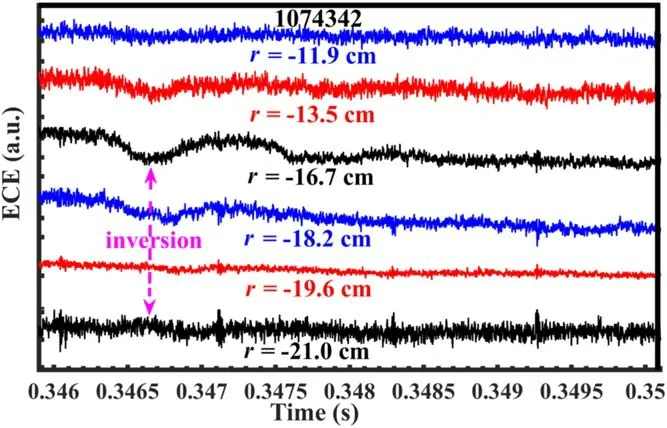
Figure 3.Time traces of six ECE measurement channels taken in different locations,corresponding to the green shadow area in figure 2.
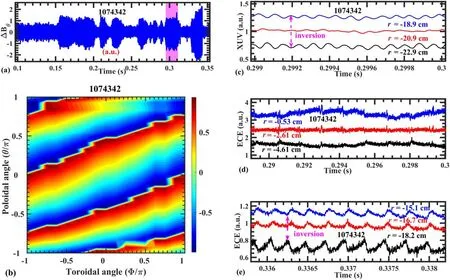
Figure 4.(a)Time traces of Mirnov signal,(b)the mode number and(c)the three XUV channels at different locations in purple shadow area of (a),(d) and (e) are the phase reversal positions of sawtooth and 2/1 island,respectively.

Figure 5.Time traces of ECE measurement channels taken in different locations for the minor disruption.

Figure 6.Images of the temperature disturbance from ECEI diagnostic at time points (a)-(f).

Figure 7.Contour plot of temperature perturbations measured by 24-channel ECE.
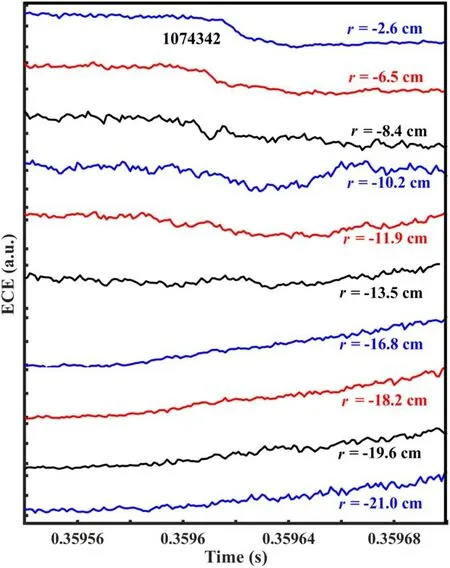
Figure 8.Time traces of multiple ECE measurement channels to detect major disruptions at different locations for major disruption.
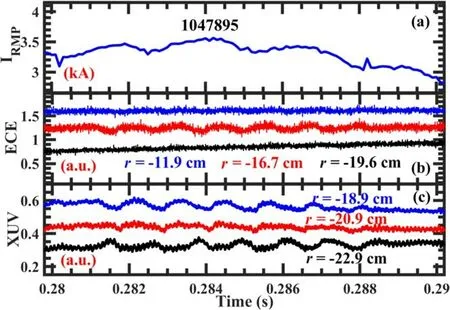
Figure 9.After penetration of(a)2/1 RMP,six periodic oscillations were observed on the signals of(b)electron temperature ECE and(c)thermal radiation XUV for shot 1047895.
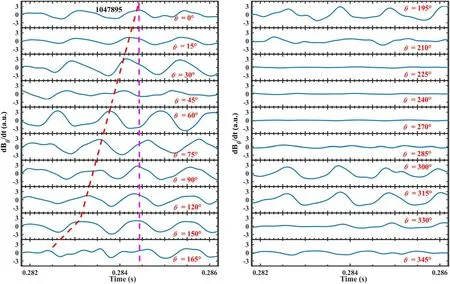
Figure 10.The signals of poloidal magnetic probe array during oscillations in figure 9.

Figure 11.Time traces of multiple ECE measurement channels to detect minor disruptions at different locations.
After determining the locations of 3/1 and 2/1 modes,their effect on minor disruption will be studied.As shown in figure 5,when minor disruption occurs,the temperature collapse happens first at r=-13.5 cm (inner side of the 2/1 magnetic island),and then spreads outward step by step.It almost reaches the position of r=-19.6 cm (the position of oscillations) and r=-21.0 cm simultaneously,which is similar to the randomization phenomenon of boundary magnetic island described in [14].This may mean 2/1 and 3/1 islands are coupled.Moreover,the temperature collapse inside r=-13.5 cm propagates inward during the minor disruption,but the ECE signals at r=-8.4 cm and r=-10.2 cm increase first and then decrease.ECEI arrays are used to explain this phenomenon.
In figure 6,the upper signals in each small plot are the ones at r=-9.45 cm in the ECEI arrays.The red circle in each upper plot indicates the time point corresponding to the ECEI signals below.As shown in figures 6(a)-(c),a magnetic island close to r=-8.4 cm and r=-10.2 cm grows before and during the temperature collapse of the minor disruption,and then,as shown in figures 6(d)-(f),the size of this island continuously decreases during the recovery of the minor disruption so that it could even disappear.It can be also seen from figures 6(a)-(f) that the decrease of the temperature outside r=-10.2 cm in the horizontal plane at Z=0 cm propagates continuously inwards,which leads to a decrease in the temperature of the plasma core.On the other hand,in the horizontal plane at Z=12 cm,the heat from the core propagates continuously outwards,which causes the temperature in the region beyond r=-15 cm to grow.Therefore,the magnetic island around r=-8.4 cm and r=-10.2 cm exists as a channel for the transfer of thermal energy from the core during minor disruption.The mode number of this mode is not clear.But,form figures 4(d) and (e),the positions of q=1 and q=2 are at r=-2.6 cm and r=-16.7 cm before mode-locking,this mode may be 3/2 island.Form figure 5,the ECE signals at r=-8.4 cm and r=-10.2 cm changes are almost consistent during the thermal collapse(the green shadow area),which may mean the coupling of 2/1 and 3/2 islands.
Since the observation range of ECEI dual-array is limited,the ECE signals in the presence of mode-locking are taken as the reference.A plot of the 24-channel ECE signals of the temperature change versus time corresponding during the mode-locking is presented in figure 7.In this figure,the 3/1 position and 2/1 position denote respectively the positions of the 3/1 and 2/1 magnetic islands before modelocking.As shown in figure 7,the temperature collapse of minor disruption occurs when the cooling region at the original 3/1 magnetic island at the boundary expands to the position of the original 2/1 magnetic island.It can also be seen that the temperature collapse had little effect on the plasma core.After that,the temperature recovers and the cooling region at the boundary reduces.However,the perturbation field remains,so that major disruption subsequently occurs when the cooling region of the boundary reaches the original 2/1 magnetic island position again.The multichannel ECE signals for the major disruption are shown in detail in figure 8.In contrast to the minor disruption presented in figure 5,the behavior of the major disruption is almost identical in the region beyond r=-13.5 cm,probably because the whole region outside of r=-13.5 cm is randomized.This means that the temperature collapse of major disruption occurs first at r=-13.5 cm.Therefore,the temperature in the inner region of r=-13.5 cm drops.When the collapse occurs close to the core of plasma,the temperature at r=-10.2 cm increases,while the behavior of the outer regions remains consistent.This is similar to the behavior of the disruption reported in[18],where the collapse occurs first at the 2/1 magnetic island and then again in the core.So,during the major disruption,the coupling of 2/1 and other islands may also happen.
The analysis of the 3/1 and 3/2 islands above is not fully explained,and the oscillations are a general phenomenon during 2/1 mode-locking.To determine the mode number of the oscillation,the discharge of shot 1047895 is analyzed.This shot is a sawtooth discharge.2/1 RMP adds at t=0.24 s,and the current of RMP rises to 3.5 kA at t=0.285 s,and then decreases again(figure 9(a)).The sawtooth disappears at about t=0.262 s,and a locked 2/1 magnetic island appears.It can be seen from figures 9(b) and (c) that during the 2/1 mode-locking,a 6-period oscillation signal with a frequency of about 750 Hz is also detected.This signal is just at the lower limit of the range that the Mirnov coil can pick up.The variation of the multi-channel Mirnov signals during the oscillations is shown in figure 10.In this figure,θ=0°corresponds to the middle plane of the low field side,and the increase of θ indicates its rotation anticlockwise along the middle plane.It can be seen that the signal corresponding to the lower half-plane is very weak.The analysis of the signal corresponding to the upper half-plane shows that this mode has about 1.5 cycles in the 180° range,so the poloidal mode number of the oscillation is m=3.From the analysis carried out above,the oscillation takes place at the boundary of plasma(outside the 2/1 magnetic island).Therefore,one may assume that this oscillation is caused by the 3/1 magnetic island.
In addition to the oscillations,the magnetic island that grows during the temperature collapse of minor disruption in figure 6 is also common.Figure 11 shows a sawtooth discharge for shot 1048477,after the penetration of 2/1 RMP,2/1 a minor disruption happens at t=0.3188 s.A magnetic island around r=-10.9 cm with opposite changes in temperature at r=-9.2 cm and r=-12.6 cm is observed from t=0.319 s to 0.321 s.During the temperature recovery of the minor disruption after t=0.3213 s,a perturbation with increasing frequency and decreasing amplitude is observed on both sides of r=-10.9 cm.The mode number of this perturbation m/n=3/2 is obtained by using the cross-power spectrum analysis (figure 12).This means 3/2 (with 2/1 and 3/1) island really plays a role in the disruption.
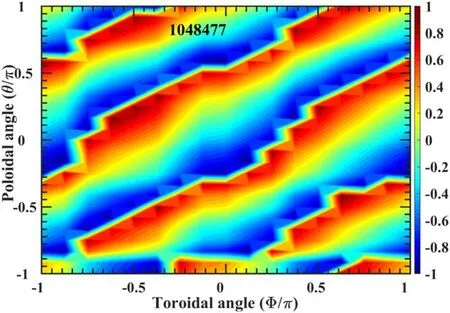
Figure 12.The island mode number near r=-10.9 cm.
3.Discussion and conclusions
In this work,minor disruption is studied by applying static m/n=2/1 RMPs to the J-TEXT plasmas Ohmic discharge.It is found that oscillation and minor disruption could occur at sufficiently high magnetic perturbations.Prior to the minor and/or major disruption,oscillations are observed during the 2/1 island mode-locking if the edge safety factor qa>3.The analysis also shows that the oscillations are caused by the 3/1 island.It seems that during the 2/1 mode-locking,the 3/1 and 2/1 islands grow due to the RMP or edge cooling,and then,they are locked to a suitable phase,like[32],so that the 3/1 island has one to several cycles of slow rotation,which looks like oscillations.
During the minor disruption,2/1,3/2 and 3/1 islands may be the channels for the thermal energy,and they may also be coupled.It should be noticed that the behavior of plasma in the core (maybe 1/1 mode) is not clear.More attention to its study would be given in the future.In addition,the details of island interaction before and during a (minor)disruption are still not very clear.In the future,this interaction would be studied by using 2D electron cyclotron emission imaging (ECEI) and auxiliary heating,such as electron cyclotron resonance heating (ECRH) [33].The ECEI could help to observe the evolution and interaction of magnetic islands and contribute to the understanding of disruption phenomena like KSTAR[18].ECRH could be used to control the size of islands and possibly to prevent disruption.
As discussed above,after the 2/1 RMP penetration,3/2,2/1 and 3/1 islands are related to the thermal collapse of the minor disruption.Moreover,low-q limit disruption and density limit disruption are also found that 2/1 and 3/2 play roles in the minor disruption.Therefore,the relationship between MHD modes and disruptions is not causal.This aspect will be studied in detail in the future.
One may summarize that in this work,the discharge at qa>3 at the external resonant magnetic perturbations is studied on the J-TEXT tokamak.Oscillations as well as minor and/or major disruptions occur after 2/1 mode-locking.The oscillations are caused by 3/1 island,and 3/1,2/1 and 3/2 islands play roles in the disruption.
Acknowledgments
The authors would like to thank the members of the J-TEXT team for their assistance in the experiment.This work is supported by National MCF Energy R&D Program of China(No.2018YFE0310300),National Natural Science Foundation of China (Nos.51821005,51977221 and 61903384),Fundamental Research Funds for the Central Universities(No.CZY20028),Startup Funds for the Introduction of Talents,South-Central Minzu University (No.YZZ19026).
猜你喜欢
杂志排行
Plasma Science and Technology的其它文章
- Recent progress on the J-TEXT three-wave polarimeter-interferometer
- Design of the stripping unit and the electromagnetic analysis unit for the E//B NPA on HL-2A/2M tokamak
- Space-resolved vacuum-ultraviolet spectroscopy for measuring impurity emission from divertor region of EAST tokamak
- Development of a combined interferometer using millimeter wave solid state source and a far infrared laser on ENN’s XuanLong-50(EXL-50)
- Bench test of interferometer measurement for the Keda Reconnection eXperiment device (KRX)
- Neutron yield measurement system of HL-2A tokamak
